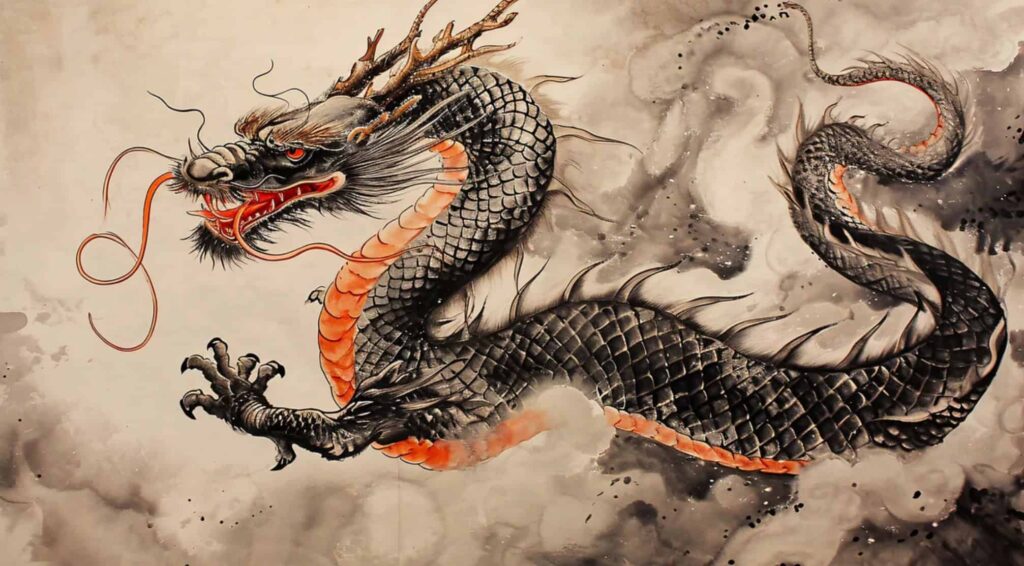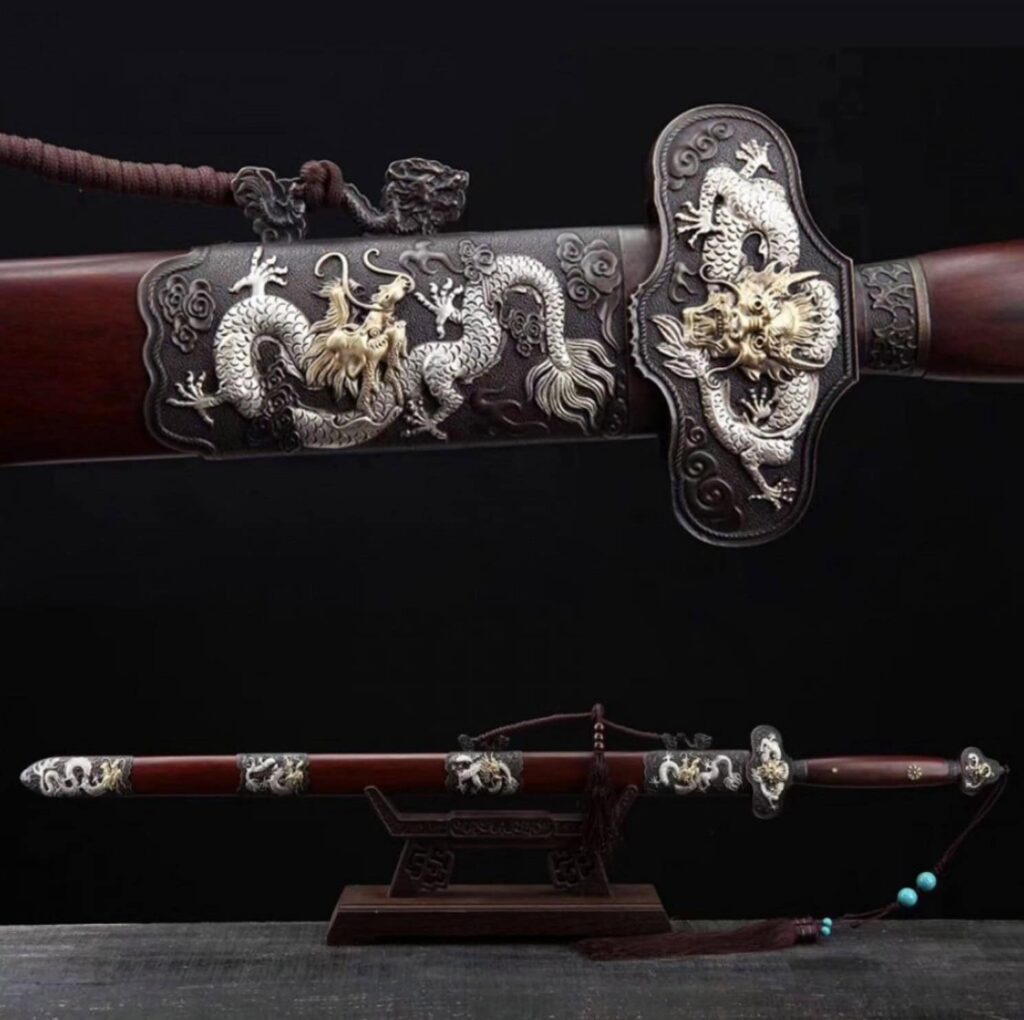The Chinese Dragon Sword – My Top Picks
TLDR: The Chinese dragon sword features intricate designs, including dragon motifs, unique color schemes, and craftsmanship with precious materials like jade and gold.
You know, there’s something truly mesmerizing about a Chinese dragon sword. The first time I laid eyes on one, I was completely blown away. The way the light dances off the intricate engravings, the balance of the blade in your hand – it’s like holding a piece of history and art all at once. I’m no expert, but I’ve spent countless hours poring over books and websites, trying to understand every detail of these magnificent weapons. From the blade to the scabbard, each element tells a story of craftsmanship that’s been honed over centuries.
Blade Characteristics of the Chinese Dragon Sword
When it comes to the Chinese dragon sword, the blade is truly where the magic happens. These blades are typically crafted from folded steel or pattern-welded steel, resulting in a mesmerizing damascus-like appearance. The folding process not only creates beautiful patterns but also enhances the blade’s strength and flexibility. As someone who’s spent countless hours examining these swords, I’m always in awe of the intricate patterns that emerge from the folding process.
The shape of a Chinese dragon sword blade is characteristically straight and double-edged, designed for both slashing and thrusting techniques. This versatility makes it a formidable weapon in skilled hands. The blade length can vary, but it generally ranges from 70 to 80 centimeters, with an overall length of around 100 to 110 centimeters when including the handle. I’ve found that this length provides an excellent balance between reach and maneuverability.
One aspect that fascinates me is the heat treatment and tempering techniques used in crafting these blades. The process typically involves:
- Heating the blade to austenization temperature (around 800°C)
- Quenching in water or oil to rapidly cool and harden the steel
- Tempering at a lower temperature to reduce brittleness and increase toughness
The heat treatment process is crucial in achieving the desired hardness and flexibility of the Chinese dragon sword blade. Swordsmiths often use a differential hardening technique, where the edge is made harder than the spine. This results in a blade that maintains a sharp edge while remaining flexible enough to absorb impacts without breaking.
Handle Design of the Chinese Dragon Sword
The handle design of the Chinese dragon sword is a testament to both functionality and artistry. Typically, these handles are crafted from a combination of materials, each chosen for its specific properties. Wood forms the core, providing a lightweight yet sturdy base. Ray skin, known as samegawa, is often wrapped around the wood, offering an excellent grip even in humid conditions. Brass fittings are commonly used to reinforce the structure and add decorative elements.
What truly sets the Chinese dragon sword handle apart is its intricate dragon motifs. These designs are not merely ornamental; they embody deep cultural significance. Craftsmen meticulously carve or engrave dragon patterns into the handle, often depicting the creature’s sinuous body wrapping around the grip. The level of detail can be astounding, with scales, claws, and whiskers rendered in exquisite precision.
The wrapping techniques used on Chinese dragon sword handles are diverse and complex. One common method involves using cord or leather strips to create an intricate pattern that not only enhances grip but also contributes to the overall aesthetic.
Guard (Tsuba) Features of the Chinese Dragon Sword
The guard, or tsuba, of a Chinese dragon sword is a crucial component that serves both functional and aesthetic purposes. Typically crafted from brass or copper, these guards are renowned for their intricate dragon-inspired designs. The choice of materials is not arbitrary; brass and copper are favored for their durability, malleability, and resistance to corrosion, ensuring the guard maintains its beauty and functionality over time.
Dragon-inspired shapes and designs on the tsuba are a hallmark of the Chinese dragon sword. These designs often depict sinuous dragon bodies, fierce dragon heads, or stylized dragon scales. The level of detail can be astounding, with some guards featuring dragons chasing flaming pearls or intertwined with clouds and waves. These motifs are not merely decorative; they embody cultural symbolism and showcase the skill of the craftsman.
The primary function of the tsuba is to prevent the wielder’s hand from sliding onto the blade during use. However, on the Chinese dragon sword, it also serves to balance the weapon and contribute to its overall aesthetics. The guard’s size and weight are carefully considered to ensure optimal handling and performance.
Here’s a breakdown of common dragon motifs found on Chinese dragon sword guards:
- Coiling dragon
- Dragon in pursuit of a flaming pearl
- Twin dragons facing each other
- Dragon emerging from waves
- Dragon among clouds
The aesthetic appeal of these guards cannot be overstated. They often feature a combination of techniques such as openwork, relief carving, and inlay to create depth and texture. Here’s a comparison of common decorative techniques used:
| Technique | Description | Visual Impact |
| Openwork | Cutting through the metal to create negative space | Creates a lace-like appearance |
| Relief carving | Raising designs above the background | Adds depth and dimensionality |
| Inlay | Inserting precious metals or stones | Enhances contrast and luxury |
As an enthusiast, I find myself constantly marveling at the artistry displayed in these guards. The way craftsmen manage to capture the essence of a dragon in such a small space is truly remarkable. My personal favorite is a guard I once saw that depicted a dragon emerging from turbulent waves, its scales so finely detailed that they seemed to shimmer in the light.
Pommel Artistry on the Chinese Dragon Sword
The pommel of a Chinese dragon sword is a masterpiece of artistry and functionality. This crucial component, located at the end of the sword’s hilt, often features exquisite dragon-themed engravings and sculptures. These designs range from intricate bas-relief carvings to fully three-dimensional dragon figures, each showcasing the craftsman’s skill and attention to detail.
Materials used for Chinese dragon sword pommels vary, with brass, gold, and jade being among the most prized. Brass pommels are common, offering durability and a rich, warm color that complements the overall aesthetic of the sword. Gold pommels, while rarer, signify luxury and status, often reserved for high-ranking officials or ceremonial weapons. Jade pommels, particularly those from the Warring States period (475-221 BCE), are especially noteworthy for their historical and cultural significance.
The functional aspects of the pommel design are equally important as its decorative elements. The pommel serves as a counterweight, balancing the sword and improving its handling characteristics. Some pommels feature a ring design, known as a “ring-pommel,” which not only adds to the aesthetic appeal but also serves practical purposes. These rings can be used to attach decorative tassels or to secure the sword to the wielder’s wrist, preventing disarmament during combat.
| Pommel Type | Material | Significance |
| Ring-pommel | Brass | Common, versatile |
| Solid jade | Jade | High status, ceremonial |
| Gold dragon | Gold | Imperial or noble ownership |
| Carved brass | Brass | Military rank indicator |
Scabbard Craftsmanship for the Chinese Dragon Sword
The scabbard of a Chinese dragon sword is a masterpiece of craftsmanship, combining functionality with exquisite artistry. Typically crafted from high-quality woods such as ebony or rosewood, these scabbards are not merely protective sheaths but works of art in their own right. Ebony, prized for its deep black color and dense grain, offers durability and a luxurious appearance. Rosewood, with its rich reddish-brown hue, provides a warm, elegant backdrop for intricate decorations.
Dragon carvings and inlays are the hallmark of Chinese dragon sword scabbards. Skilled artisans meticulously carve sinuous dragon forms along the length of the scabbard, often depicting the creature in various poses – coiling, writhing, or chasing the elusive pearl of wisdom. These carvings can be shallow relief work or deeply incised, creating a three-dimensional effect that brings the dragon to life. Inlays of precious materials like mother-of-pearl, jade, or even gold are sometimes used to accentuate specific details, such as the dragon’s eyes or scales, adding depth and luminosity to the design.
Metalwork plays a crucial role in both the structural integrity and decorative aspects of the scabbard. Brass or copper fittings, known as “mounts,” are strategically placed along the scabbard’s length. These serve to reinforce the wood and prevent splitting, while also providing opportunities for additional ornamentation.
| Material | Durability | Aesthetic Appeal | Traditional Use |
| Ebony | High | Elegant, formal | Imperial, ceremonial |
| Rosewood | Medium-high | Warm, rich | Military, civilian |
| Hua Lee | Medium | Versatile | Common, affordable |
Unique Aesthetic Elements of the Chinese Dragon Sword
The Chinese dragon sword is renowned for its unique aesthetic elements that set it apart from other blades. One of the most striking features is the color scheme employed in its design, which carries deep symbolic significance. The colors used in dragon motifs on these swords are not merely decorative but convey specific meanings. For instance, a red dragon symbolizes good fortune and luck, while a golden dragon represents power, wealth, and prosperity. Black dragons, often associated with vengeance or evil, add a sense of mystery and power to the sword’s appearance.
Intricate engraving techniques are a hallmark of Chinese dragon sword craftsmanship. Artisans employ various methods to create stunning designs on the blade, including hand engraving and etching. These techniques allow for the creation of incredibly detailed dragon motifs, with each scale, claw, and whisker meticulously rendered. The level of precision in these engravings is truly remarkable, often incorporating cloud and wave patterns to emphasize the dragon’s mythical nature and fluidity of movement.
The integration of precious materials further enhances the aesthetic appeal of Chinese dragon swords. Craftsmen often incorporate materials such as coral and ivory into the design, particularly in the handle and scabbard. These elements not only add to the sword’s visual splendor but also increase its value and prestige. In some cases, artisans use gold or silver inlay to highlight specific aspects of the dragon design, creating a stunning contrast against the darker steel of the blade.
Here’s a table showcasing the significance of different dragon colors on Chinese dragon swords:
| Dragon Color | Symbolism |
| Red | Luck and good fortune |
| Golden | Power, wealth, prosperity |
| Black | Vengeance or evil |
| White | Purity and virtue |
| Blue/Green | New life, growth, spring |
| Yellow | Wisdom, good fortune, imperial power |
Chinese Dragon Sword Top Picks
Discover our curated selection of Chinese Dragon Swords, blending the artistry of traditional craftsmanship with the mystique of legendary dragons. These top picks showcase stunning designs, intricate details, and excellent balance, perfect for collectors, martial artists, or anyone captivated by the timeless allure of Chinese culture.
Lóng Shén Jian Sword
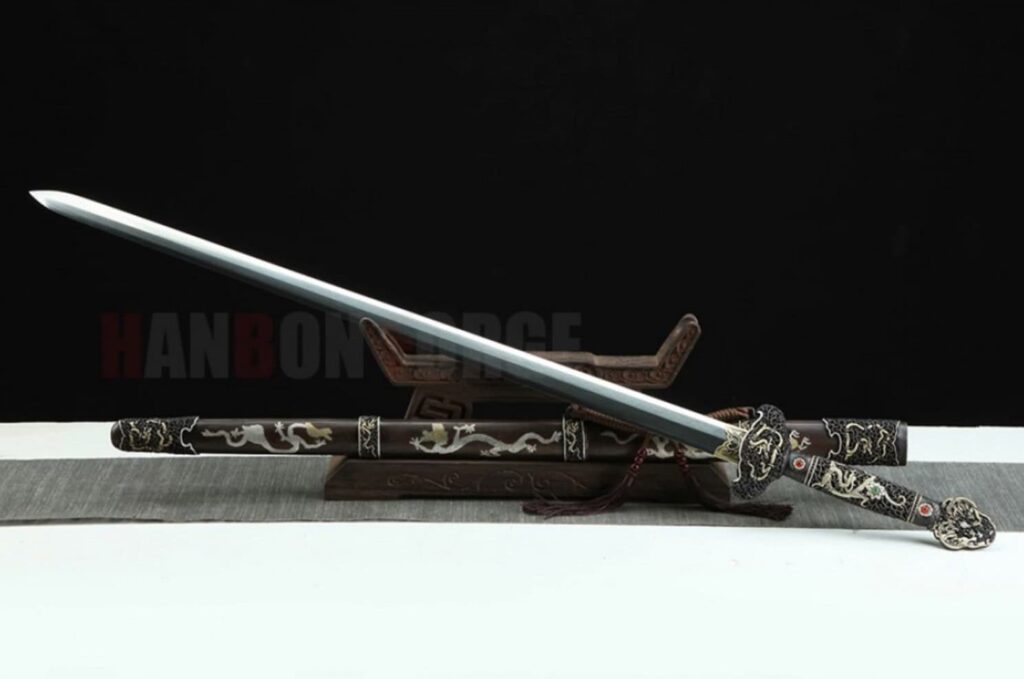
What I Like:
- Exquisite Craftsmanship: The blade is forged from patterned steel, hand-polished, and clay-tempered for exceptional durability and hardness, making it ideal for martial arts training or display.
- Premium Design: Features brass dragon-themed fittings, a moisture-resistant scabbard, and matching engraved copper accents for both functionality and elegance.
- Versatile Use: Perfect for Tai Chi, Kung Fu, cutting practice, or as a collector’s piece, with a full-tang, fully disassemblable design and an included sword bag for protection.
Han Dynasty Dragon Jian Sword
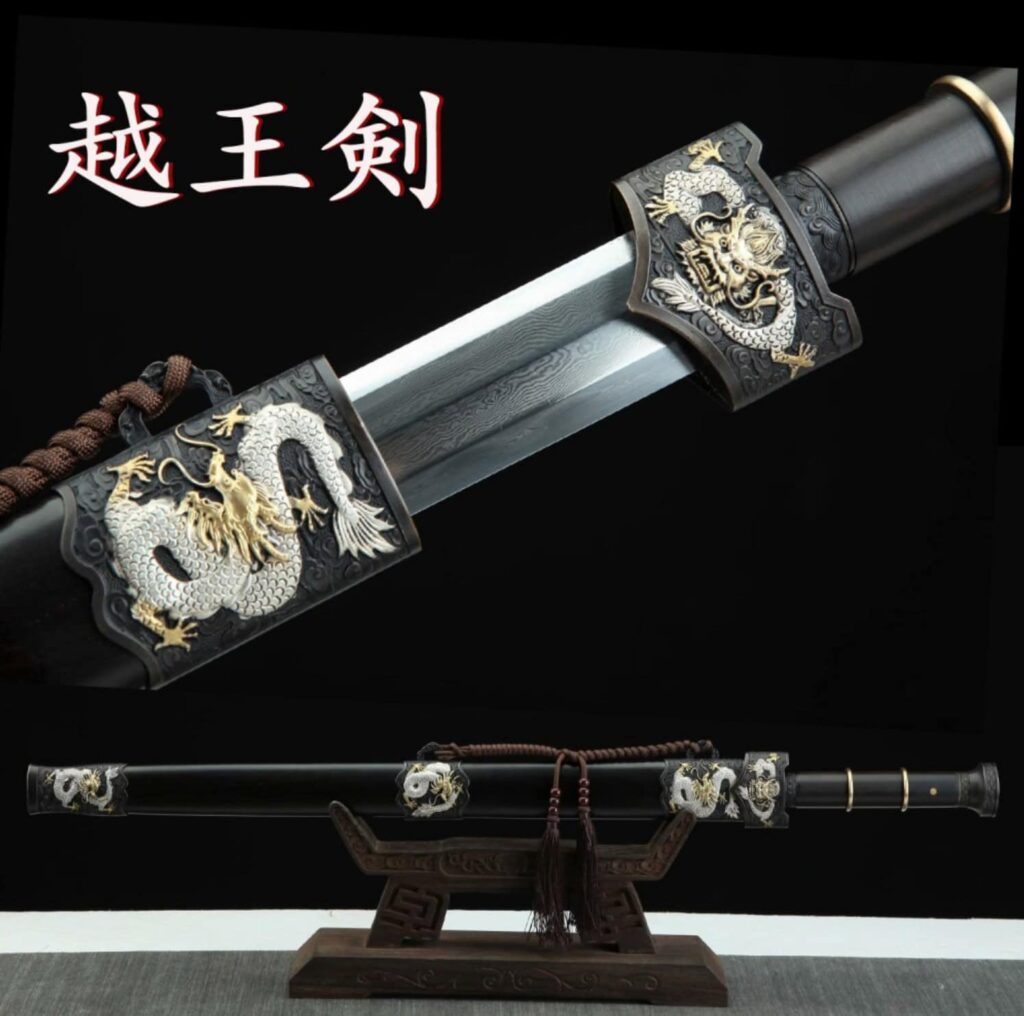
What I Like:
- Exquisite Craftsmanship: The blade is hand-forged from patterned steel using traditional Chinese methods, featuring a stunning hamon and folded pattern for durability and beauty.
- Elegant Design: The ebony scabbard and handle are adorned with intricate brass dragon fittings, symbolizing status and good fortune in ancient China.
- Versatile Use: This sword is perfect for martial arts practice, home display, gifting, or as a valuable collector’s item.
Dragon Fumoren Jian Sword

What I Like:
- Exquisite Blade Craftsmanship: The blade is forged from pattern steel folded 13 times into 8,192 layers, creating visible grain patterns and superior strength, flexibility, and beauty.
- Premium Materials and Design: The ebony wood scabbard and handle are complemented by hand-carved brass fittings and a pure copper design, enhancing both aesthetics and durability.
- Traditional Forging Excellence: Hand-polished using Japanese sharpening methods, the full-tang, double-edged blade features a genuine hamon and is perfect for collectors.
Fenghuang Jian Sword
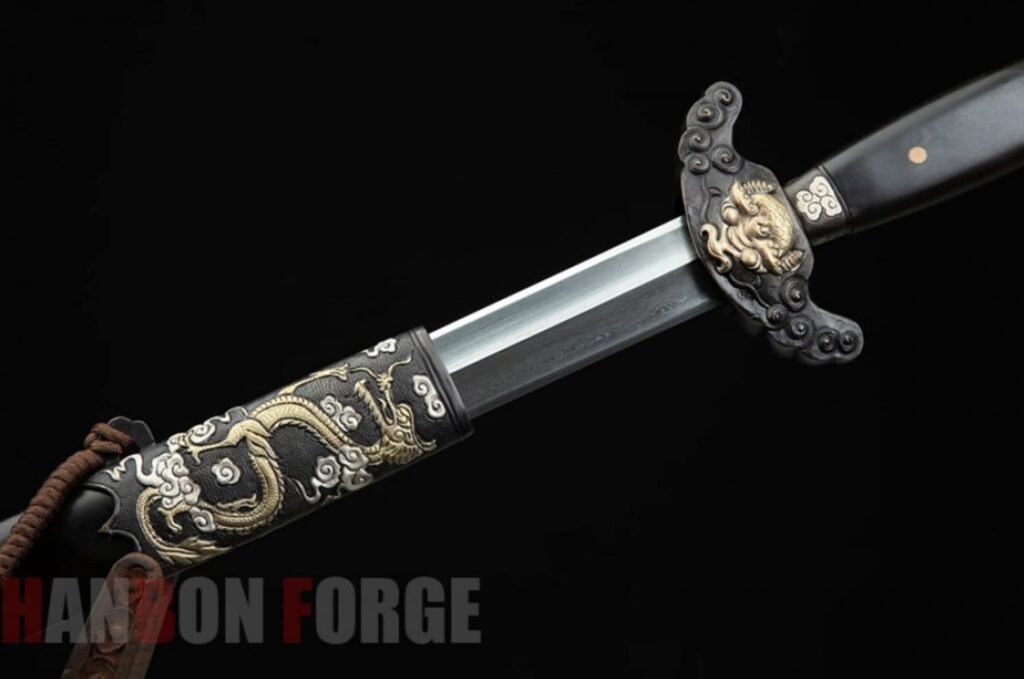
What I Like:
- Premium Craftsmanship: The blade is made of heat-treated, tempered, and oil-quenched folded steel, offering exceptional durability and sharpness.
- Elegant Design: Adorned with brass fittings and an ebony scabbard carved with dragon and phoenix patterns, this Jian symbolizes power and auspicious fortune.
- Versatile Utility: Featuring a full tang secured by bamboo pegs, it is ideal for tai chi, kung fu, wushu practice, or as a stunning display piece.
Dragon Spirit Han Jian Sword
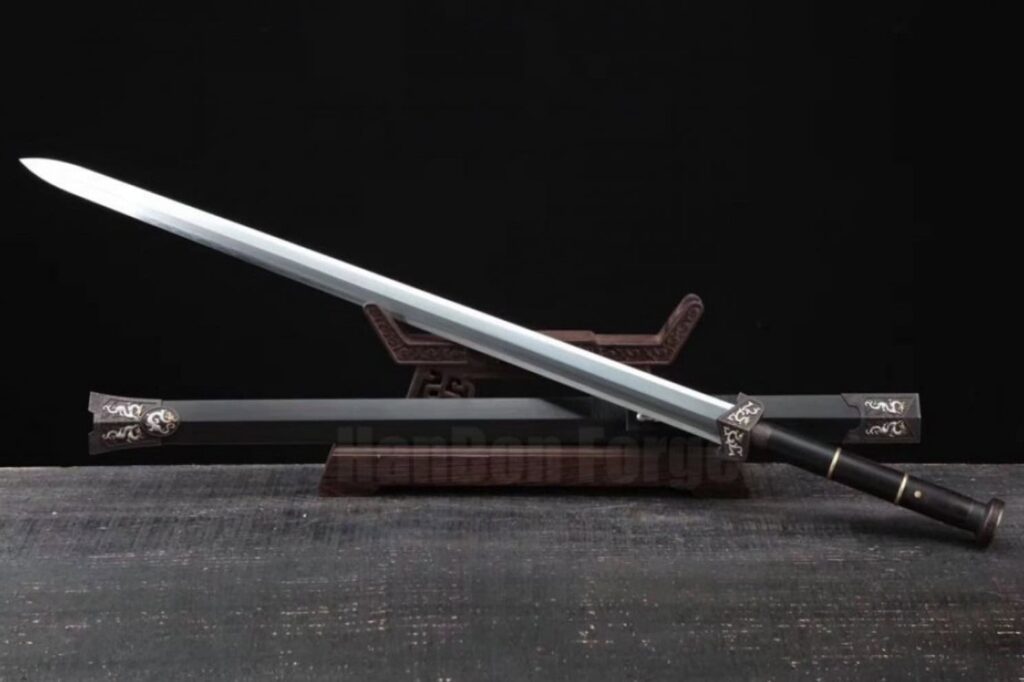
What I Like:
- Exquisite Blade Craftsmanship: Forged from Damascus folded steel and clay-tempered, this blade boasts 8192 layers and a visible hamon, combining incredible strength with flexibility.
- Elegant Design: The handle and scabbard are crafted from black ebony wood, complemented by hand-polished tricolor copper dragon fittings for a striking, traditional look.
- Functional and Secure: Fully capable of traditional use, the double-edged, full-tang blade features a secure pegged handle and exceptional balance.
Ancient Dragon Damascus Jian Sword
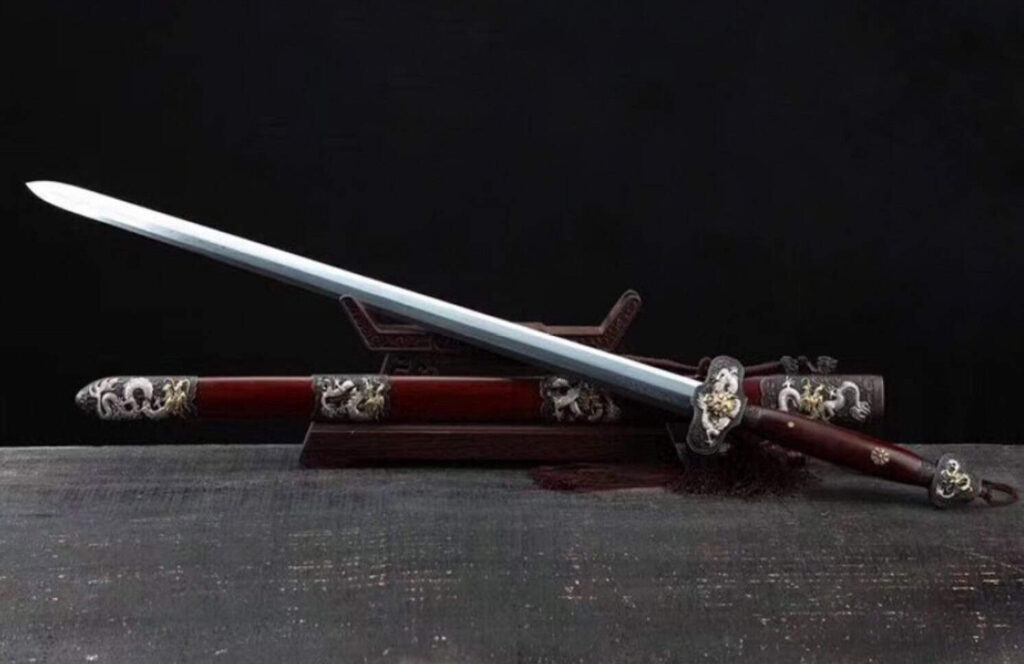
What I Like:
- Exquisite Craftsmanship: The eight-sided Damascus folded steel blade, polished with hazuya, showcases 8192 layers of visible grain (HADA) for unmatched beauty and precision.
- Premium Materials: The handle and scabbard are made from hard rosewood, adorned with intricate brass mountings featuring a stunning three-color dragon design in gold, silver, and bronze.
- Versatile Performance: Perfect for advanced Tai Chi, Kung Fu, or cutting practice, this double-edged, full-tang Jian is both functional and elegant.
Final Thoughts
As I wrap up this exploration of the Chinese dragon sword, I can’t help but feel a sense of awe. The more I learn about these incredible weapons, the more I appreciate the skill and artistry that goes into creating them.

